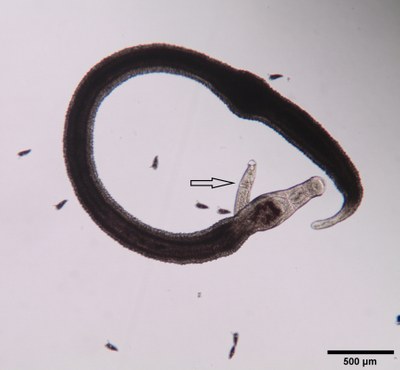Working group Schistosoma
Our working group is settled in the field of molecular parasitology. One focus of research is the worm parasite Schistosoma mansoni. As member of the parasitic platyhelminths this blood-fluke causes schistosomiasis (Bilharzia), an infectious disease of worldwide significance for humans and animals. With respect to parasitic disease for humans, the relevance of schistosomiasis is second only to malaria.
|
|
|---|
|
Schistosome couple in vitro. The female resides within the ventral groove of a male (gynecophoric canal) but parts can protrude (see arrow). The small surrounding structures are eggs laid in vitro. |
Besides its medical relevance, schistosomes exhibit two biological peculiarities. They are the only dioeciously living members of the class of mostly hermaphroditic trematodes (see image). Another biological particularity of schistosomes is that the male induces the sexual maturation of the female. The reproductive organs of the female develop only as consequence of a constant pairing contact that can last over years. This is a prerequisite for egg production but a reversible process. Upon separation from its male partner, the female degenerates sexually and egg production will stop. Re-pairing, however, restarts differentiation of the reproductive organs in females, and egg production will be resumed.
Egg production is not only essential for the perpetuation of the schistosomes life cycle, it is equally important for the pathologic consequences of schistosomiasis (Bilharzia). Only part of the eggs reach the environment via feces or urine. The other part of the eggs can lodge in inner organs of patients such as the liver, where severe inflammatory processes are induced. Finally, this can lead to liver fibrosis.
According to the world health organization (WHO1) more than 700 million people live in endemic areas, where infections with schistosomes can occur. Large regions of Africa, South America and Asia are mainly affected. In sum about 240 million people are infected and required medical treatment. Praziquantel is the only available drug against all schistosome species, and a vaccine is not available yet.
1WHO (2020) Global Health Estimates and Fact Sheets. Available from:
http://www.who.int/healthinfo/global_burden_disease/en/
https://www.who.int/schistosomiasis/en/
http://www.who.int/features/factfiles/schistosomiasis/facts/en/

